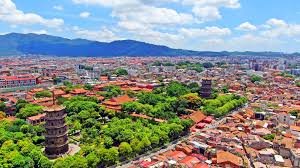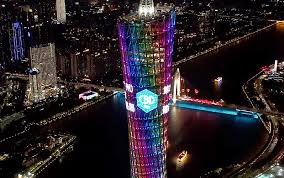In the heart of Fujian’s southeastern coast lies Quanzhou, a city that embodies the enduring spirit of China’s global engagement. For centuries, it stood as a cultural and economic bridge connecting East and West through the currents of the Maritime Silk Road.
Quanzhou has long been a meeting point of civilizations, a city that earned its global stature not through spectacle but through a steady embrace of openness, culture, and exchange.
Today, it is more than a historical port. It is a living example of how a city can honor its past while helping to shape China’s future, especially as the Belt and Road Initiative brings new life to the ancient maritime networks that Quanzhou once helped lead.

Quanzhou spans over 11,000 square kilometers and is home to nearly 9 million people. With a subtropical maritime monsoon climate and an enviable coastline, the city harmonizes natural beauty with centuries-old architecture, making it as visually striking as it is historically profound.
It was officially named Quanzhou in 711 AD, though its foundation dates even further back, to 260 AD. Once one of the busiest ports in the world during the Song and Yuan dynasties, Quanzhou served as China’s main window to maritime trade with Arabia, India, Persia, Africa, and Southeast Asia—long before modern trade corridors took form.
The city’s recognition as a UNESCO World Cultural Heritage Site in 2021 was more than symbolic. The listing includes 22 heritage sites spanning religious buildings, administrative structures, and maritime relics. These are not remnants of a distant past, but they are vivid reflections of how Quanzhou has always stood at the intersection of commerce, culture, and cross-civilizational dialogue.
The Kaiyuan Temple, with its 1,300-year-old history, towers with its East and West pagodas, while Tianhou Temple honors the sea goddess Mazu, revered by seafaring communities across Asia. Xunpu Village, known for its floral headpiece culture, and Qingyuan Mountain, home to Taoist relics and the Laozi rock carving, enrich this multifaceted identity.

Yet Quanzhou’s significance goes beyond heritage. It is a city with a GDP surpassing 1.3 trillion RMB (as of 2024) and a per capita GDP of 137,060 RMB, driven by a blend of traditional industries, port logistics, manufacturing, and cultural tourism. With modern infrastructure such as the Quanzhou Jinjiang International Airport, multiple railway stations, and expansive port facilities, the city remains a hub—not only for goods, but also for people, ideas, and investments.
As China revitalizes its coastal and port infrastructure to connect Asia with Africa and Europe through sea routes, Quanzhou’s historic significance gives it natural strategic relevance.
But numbers only tell part of the story. What gives Quanzhou its remarkable identity is how it merges tradition with innovation. The city’s architectural fabric is a living museum — Kaiyuan Temple, built during the Tang dynasty, remains the largest Buddhist temple in Fujian and symbolizes the fusion of Indian, Islamic, and Chinese aesthetics.
The Confucian Temple reflects local educational values, while the Tianhou Temple, dedicated to Mazu, the sea goddess, is a living spiritual site for seafarers across the Chinese-speaking world. The Southern Shaolin Temple reminds visitors of the martial arts heritage that still lives through dynamic performances. Each of these sites is not merely a structure but a vessel of historical continuity.

In recent years, Quanzhou has not only preserved these sites but also integrated them into modern urban life through immersive museums, digital archives, and public storytelling. The local government has issued legal frameworks, including the “Quanzhou: Emporium of the World in Song-Yuan China” protection regulations, and built digital platforms for heritage management.
The 2021–2035 heritage research plan confirms this long-term commitment. This blend of governance and cultural memory sets an example for global heritage cities facing the pressures of modernization.
Quanzhou’s cultural vibrancy is not confined to stone walls. Its intangible heritage is equally profound. It is the only Chinese city recognized under all three categories of UNESCO intangible cultural heritage, with over 500 traditions officially cataloged.
Among these are the ancient art forms of Liyuan Opera and Gaojia Opera, the graceful Nanyin music tradition, Hui’an women’s distinctive attire, and the legendary Quanzhou string puppetry. In the fishing village of Xunpu, the floral headpieces worn by women reflect customs passed down through generations.
From the intricate Tieguanyin tea-processing techniques to the maritime rituals like the Min-Tai Wangchuan Ceremony, Quanzhou’s traditions form a cohesive cultural ecology that is as tactile as it is timeless.

Cuisine in Quanzhou offers yet another dimension to its identity. Influenced by both mountains and sea, its culinary culture is deeply Minnan, yet open to innovation. Shacha hot pot, ginger duck stew, rice noodle porridge, and sea worm jelly are more than just local delicacies—they’re extensions of centuries-old lifestyles.
Dishes such as the taro cake and crispy vinegar pork balance texture and taste with meticulous care. The region of Dehua offers high-protein dishes made from black chicken, black rabbit, and wild mushrooms, while coastal recipes bring the essence of the Taiwan Strait into every bowl. Food in Quanzhou tells a story of abundance and cultural synthesis, and it does so with extraordinary pride.

The city’s dynamic is also youthful and outward-looking. Greater Bay Airlines’ decision to launch a daily route from Hong Kong to Quanzhou Jinjiang International Airport from July 2025 is a strategic move that bridges modern mobility with historical connectivity.
It reinforces Quanzhou’s identity as a regional travel and commerce hub, while drawing tourists to its streets, temples, markets, and museums. Cultural tourism is no longer a passive experience here; it is a curated, digitalized, and emotionally rich journey into a city that has always known how to welcome the world.
In the background of Quanzhou’s global rise is a carefully maintained balance between growth and soul. The city embraces the ethos of President Xi Jinping’s vision of cultural confidence and ecological civilization.
The heritage parks, the protection laws, and the celebratory festivals are not add-ons—they are foundational. They ensure that the city’s leap into the 21st century doesn’t erase the centuries that came before it.
Quanzhou is not simply a city that has adapted to the modern world. It is one that has shaped it — quietly, through trade and tolerance, through rituals and resilience. For China, Quanzhou is a national cultural treasure. For the Global South, it is a model of how ancient cities can rise again, not by forgetting their roots, but by turning them into stepping stones for global engagement.
Established in December 2008, The Diplomatic Insight is Pakistan’s premier diplomacy and foreign affairs magazine, available in both digital and print formats.



